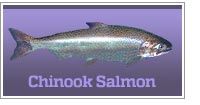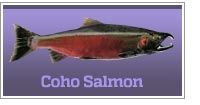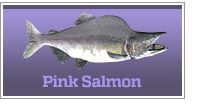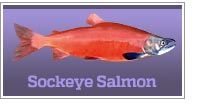Fishing For Salmon In Alaska
All about fishing for chinook, coho, chum, pink and sockeye salmon
Alaska is renowned for its world-class salmon fishing, attracting anglers from around the globe seeking a thrilling and rewarding fishing experience. The purpose of this page is to share basic information about salmon fishing and identify popular salmon waters in the state. The state boasts five primary species of salmon: Chinook (also known as king salmon), sockeye (red salmon), coho (silver salmon), pink (humpy salmon), and chum (dog salmon). Each species has its unique characteristics and behavior, providing a diverse and exciting fishing opportunity for anglers.
Chinook Salmon
One of the most sought-after salmon species in Alaska is the chinook salmon, also known as king salmon. These powerful and impressive fish can reach impressive sizes and provide anglers with thrilling battles. Lake Michigan's deep waters and nutrient-rich environment create the perfect conditions for chinook salmon to thrive. Anglers often target them by trolling with downriggers or casting spoons and crankbaits.
Chinook Salmon, like all Pacific salmon, die after spawning. They grow large and put up a great fight when hooked. Fish for chinook with down riggers to troll around the thermocline. Use flashers, trailed with bait for best results. The current Alaska state record for chinook salmon stands at over 44 pounds.
Coho Salmon
Another species of salmon found in Alaska is the coho salmon. These coho's can are often more available to be caught during the fall when they migrate closer to the shoreline. These acrobatic fish put up a fierce fight and are highly prized by anglers. Trolling with spoons, plugs, or flies is a popular method for targeting coho salmon.
Coho Salmon are smaller in size compared to other salmon but still provide a thrilling fight when hooked. Coho salmon, also called silver salmon, are another prized species targeted by anglers in Alaska. These fish are known for their aggressive nature and aerial displays when hooked. Coho salmon offer thrilling battles, often leaping out of the water and making blistering runs. They can be caught by trolling or casting near shore areas during their migratory periods. Use small spinners, or bait on a bobber setup. Good bait options include wax worms, minnows, shrimp, and nightcrawlers.
Chum salmon, while less famous than the other species, still offer a challenging and exciting fishing experience. Their aggressive strikes and strong runs make them a formidable opponent for anglers.
Pink salmon are the most abundant of all Alaska's salmon species, providing fantastic opportunities for anglers looking for fast-paced action and high catch rates. They return to Alaskan waters every two years in massive runs, making it possible for anglers to experience incredible fishing seasons.
Sockeye salmon, famous for their vibrant red color, are equally prized for their excellent taste and firm texture. They migrate in massive numbers, often creating mesmerizing displays as they swim upstream to their spawning grounds.
Each species has its specific run timing, and different regions of Alaska offer prime fishing opportunities at different times of the year. Whether you're fishing in the waters of Southeast Alaska, the Kenai Peninsula, Bristol Bay, or the Aleutian Islands, Alaska's abundant salmon populations ensure that anglers have an unforgettable fishing experience and a chance to take home some of the most prized catches in the world.
Salmon Fishing Waters in Alaska
 Find salmon fishing all across Alaska including Aleknagik Lake, Becharof Lake, Lake Clark, Iliamna Lake and many other lakes plus plenty of streams and rivers used by salmon for spawn runs. Plan a fly fishing trip to catch big salmon including king, chum, coho, pink and sockeye salmon.
Find salmon fishing all across Alaska including Aleknagik Lake, Becharof Lake, Lake Clark, Iliamna Lake and many other lakes plus plenty of streams and rivers used by salmon for spawn runs. Plan a fly fishing trip to catch big salmon including king, chum, coho, pink and sockeye salmon.
Chinook salmon
World record: 97 lbs 4 oz
State Record: 97 lbs 4 oz
Chum salmon
World record: 35 lbs 0 oz
State Record: 32 lbs 0 oz
Coho salmon
World record: 33 lbs 7 oz
State Record: 26 lbs 0 oz
Pink salmon
World record: 14 lbs 8 oz
State Record: 13 lbs 7 oz
Sockeye salmon
World record: 15 lbs 4 oz
State Record: 16 lbs 0 oz
Click the images and links above for species details.
Alaska State Record Salmon
The state record chinook (king) salmon came from the Kenai River.
The state record coho salmon was caught in the Icy Strait.
The record chum salmon was taken out of the Caamano Point
The state record pink salmon was caught from the Kenai River.
The state record sockeye salmon was caught from the Kenai River.
Alaska Salmon Fishing
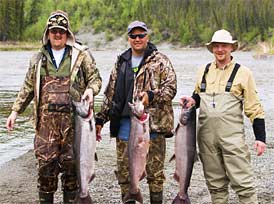 The preferred method for catching salmon is fly fishing. Depending on the activity level, salmon may be caught on wet or dry flies, as well as a variety of other lures and baits.
The preferred method for catching salmon is fly fishing. Depending on the activity level, salmon may be caught on wet or dry flies, as well as a variety of other lures and baits.
The preferred method for catching salmon is fly fishing. Depending on the activity level, salmon may be caught on wet or dry flies. For more details check here for articles about fly fishing.
About The Pacific Salmon Family
Pacific Salmon are born in and remain in freshwater streams for the early years of life. The number varies by species. Afterward they migrate to the Pacific Ocean waters where they bulk up and prepare for their once in a lifetime spawning run up the freshwater stream where they were born. They will instinctively return to their birthplace, spawn and die. They are found in the streams which empty into the ocean, and adjoining ocean waters.
Salmon Organizations
Alaska Department of Fish & Game
Visit the website for fishing reports and information about salmon fishing in Alaska.
Salmon fishing waters and information, by state
102424*




